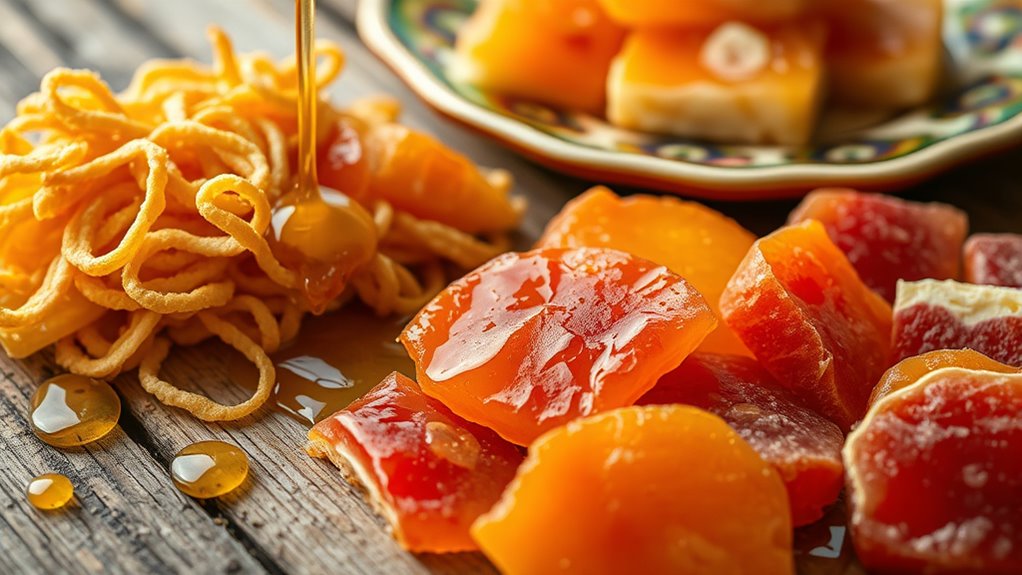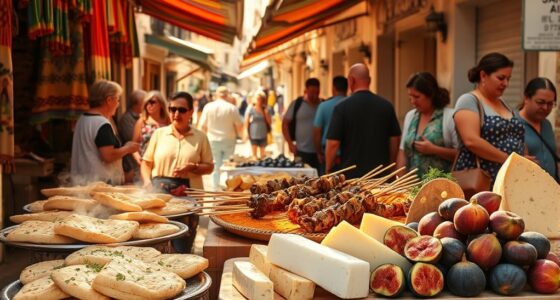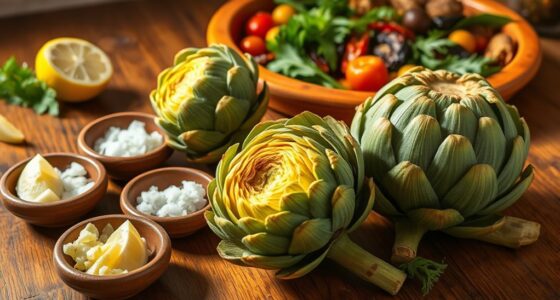Sardinian sweets like seadas and others reflect a deep cultural heritage rooted in regional ingredients such as pecorino cheese, honey, almonds, and citrus. You’ll find traditional recipes passed down through generations, especially in festivals and family gatherings. From crispy pastries to soft candies, these confections celebrate Sardinia’s agricultural richness and festive customs. To discover more about their unique flavors, preparation, and regional varieties, explore further into Sardinian culinary traditions.
Key Takeaways
- Sardinian sweets have deep cultural roots, featuring traditional ingredients like almonds, honey, citrus, and sheep’s milk cheese.
- Sebadas are iconic Sardinian pastries made with semolina dough, filled with pecorino cheese, fried, and topped with local honey.
- Regional variations include sweets like Aranzada, orillettas, and sas tiliccas, reflecting local ingredients and festive traditions.
- Traditional recipes are passed down through generations, often linked to religious festivals, weddings, and community celebrations.
- Modern pairings include local wines and liqueurs, highlighting Sardinia’s rich culinary and cultural heritage.
The Rich Heritage of Sardinian Confectionery
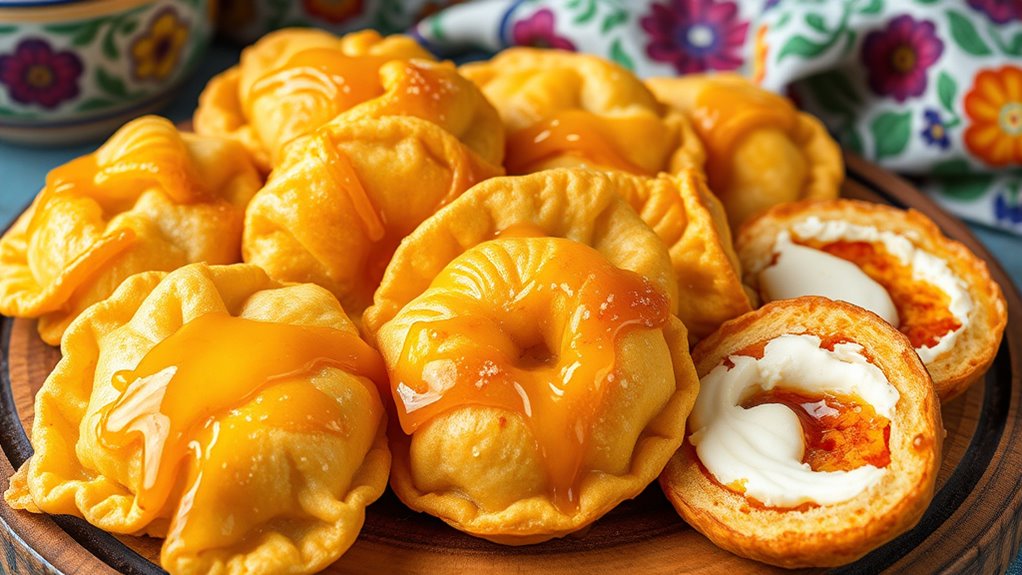
Sardinian confectionery has a rich history that spans centuries, deeply rooted in the island’s cultural identity. You’ll find almond torrone mentioned in documents as early as 1614, especially preserved in Cagliari archives. In Tonara, a village in Barbagia, artisanal torrone has long been a local tradition, symbolizing the community’s craftsmanship. Recipes for biscuits and pastries have been handed down through families, mostly by women, preserving age-old techniques. Many sweets were tied to community rituals and holidays, strengthening social bonds. Confectionery was a family effort, with relatives sharing tasks to keep traditions alive. These sweets aren’t just treats—they’re a living link to Sardinia’s history, culture, and collective identity, passed through generations with pride. Additionally, the preservation of these recipes helps safeguard the island’s cultural heritage amidst modern changes.
Exploring the Popularity of Seadas in Sardinia
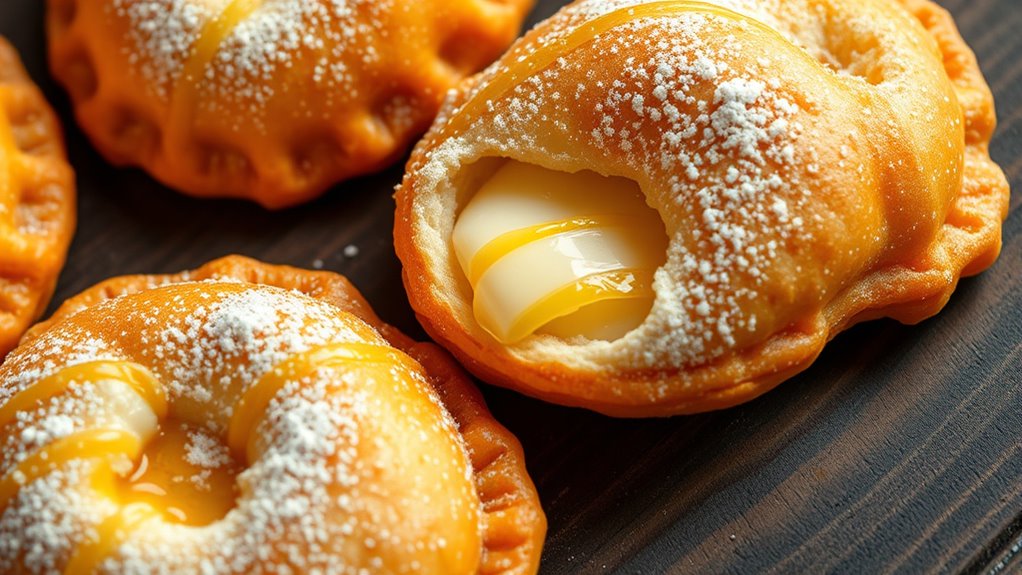
Building on Sardinia’s rich confectionery traditions, seadas stand out as one of the island’s most beloved desserts. Their roots trace back to Sardinia’s pastoral culture, especially in regions like Orgosolo and Oliena, where they celebrated shepherds’ returns. Originally, seadas weren’t sweet but hearty meals made with local ingredients, reflecting Sardinia’s complex history under Spanish rule. Over time, they evolved into a dessert, often enjoyed during Easter and Christmas, though now served year-round. Their unique flavor comes from a thin semolina dough filled with pecorino cheese, deep-fried to crispy perfection, and topped with honey from the strawberry tree. This combination’s rich taste and cultural significance have helped seadas become a symbol of Sardinia’s culinary identity, enjoyed by locals and visitors alike. The transformation of seadas into a sweet delicacy has contributed to their popularity and enduring cultural relevance. Additionally, the use of local ingredients like pecorino and honey highlights Sardinia’s culinary heritage and regional flavors.
Traditional Ingredients That Define Sardinian Sweets
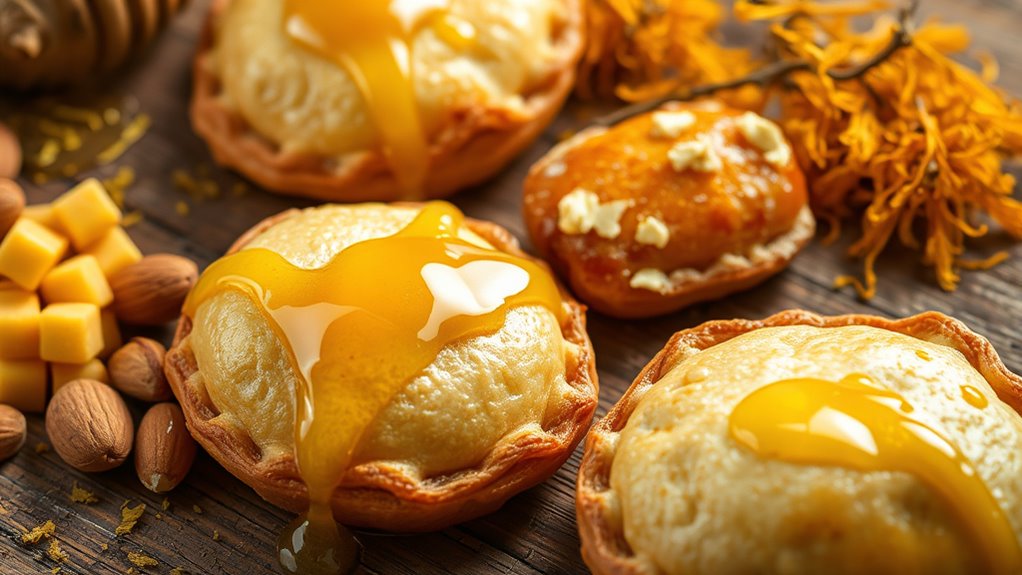
Traditional ingredients form the heart of Sardinian sweets, giving them their distinctive flavors and textures. You’ll notice durum wheat flour as the base for many doughs and pastries, often combined with lard or olive oil to soften and enrich the mixture. Sweetness comes from sugar and local honey, like strawberry tree and chestnut honey, which add aromatic depth. Grape must reduction, called “sapa,” enhances flavor and sweetness in cakes and cookies. Eggs are common, binding fillings and doughs together. Citrus zest, especially lemon and orange, provides freshness, while saffron adds color and a subtle spice, especially in cheese sweets. Nuts such as almonds, walnuts, and hazelnuts feature prominently, offering crunch and flavor. Dairy ingredients like sheep’s milk ricotta and pecorino cheese complete the traditional palette.
The Art of Making Amaretti and Its Cultural Significance

You can see how the flavor of Sardinian amaretti reflects local almond varieties and traditional techniques, making each batch unique. These cookies aren’t just treats—they’re central to celebrations and family rituals, symbolizing shared heritage. Preserving these methods keeps the cultural significance alive amid modern challenges. Amaretti are traditionally served with desserts, wine, and sweet liquors, which further enhances their cultural role. Incorporating traditional culinary techniques helps maintain the authenticity and cultural identity of Sardinian sweets.
Almond Flavor Tradition
Almond flavor holds a special place in Italian pastry, especially in the making of amaretti cookies, which are cherished for their rich aroma and delicate crunch. Historically, amaretti date back to the Middle Ages, with origins claimed by regions like Lombardy, Saronno, and Sassello. Originally made with bitter almonds or apricot kernels, they had a distinctive bitter taste that evolved over time to sweeter almonds, sugar, and egg whites. Almonds symbolize community and heritage in Italian baking, often linked to good fortune and fertility. The tradition of using almonds reflects regional pride and cultural identity. Skilled bakers craft amaretti with ground almonds or almond paste, preserving age-old techniques while embracing modern innovations. This almond flavor tradition continues to influence Italian desserts and cultural practices across generations. Regularly reviewing and adjusting recipes and techniques helps bakers maintain authenticity and adapt to contemporary tastes.
Celebratory and Ritual Use
Amaretti play an essential role in Sardinian celebrations and rituals, serving as symbols of joy, unity, and cultural pride. You’ll find them at religious festivals, weddings, baptisms, and family rites, marking important life milestones. Sharing these cookies strengthens social bonds and reinforces collective identity, as they often accompany festive meals or are given as small gifts, reflecting Sardinian hospitality. Their preparation involves traditional techniques like soaking almonds, beating egg whites, and carefully mixing sweet and bitter almonds to achieve their distinctive aroma. Each amaretti embodies cultural continuity, linking generations through centuries-old recipes. Variations exist across villages, with some adding lemon zest or vanilla. These cookies symbolize resilience, agricultural bounty, and spiritual offerings, making them integral to Sardinian rituals and celebrations. The art of making amaretti also involves precise timing and technique, which are passed down through generations, ensuring the preservation of this traditional craft. Additionally, traditional baking methods contribute to the unique texture and flavor profile that distinguish authentic amaretti from other almond cookies.
Regional Variations of Sardinian Pastries and Candies
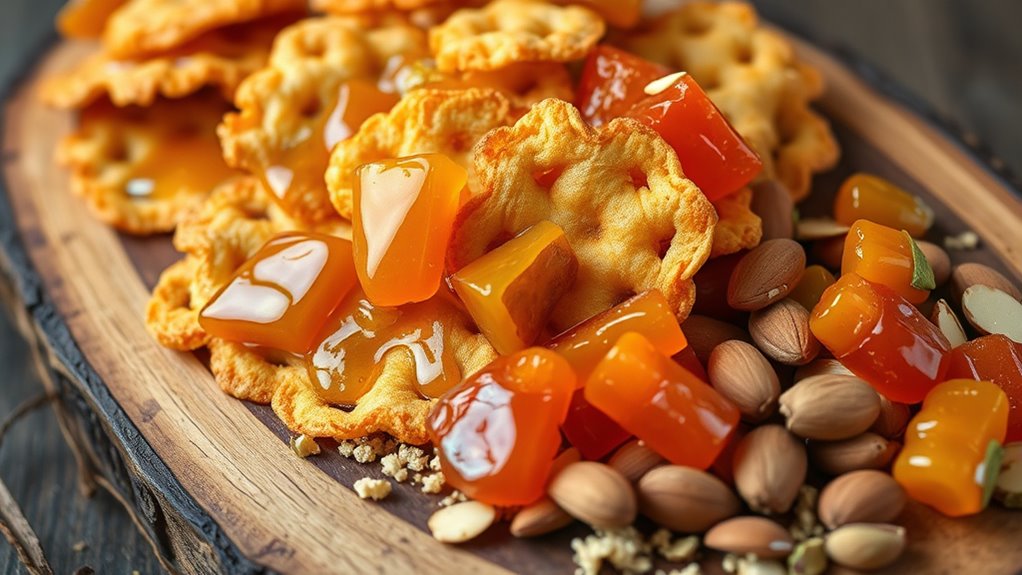
You’ll notice how local ingredients like almonds, citrus, honey, and various cheeses shape Sardinian pastries differently across regions. Each area has its own recipes and preparation methods that reflect its unique flavors and traditions. Exploring these variations reveals how geography and history influence the island’s sweet creations. These regional differences are often showcased in the presentation and specific fillings of sweets like sebadas and copulettas. Additionally, cultural influences contribute to the unique characteristics of Sardinian confections, highlighting the island’s diverse culinary heritage.
Local Ingredient Influences
Regional variations of Sardinian pastries and candies are deeply shaped by the island’s unique local ingredients. Almonds, both sweet and bitter, are essential in many sweets like Amaretti and Aranzada, offering layered flavors from honey, citrus peel, and sugar. Sheep’s ricotta provides a creamy, tangy base for cheese-based treats such as pardulas, reflecting Sardinia’s pastoral roots. Semolina and wheat flours form the backbone of many pastries and fried confections, giving them rustic texture. Honey from Sardinian bees, often infused with citrus zest, adds sweetness and aroma. Citrus peels, especially lemon and orange, are candied or infused, brightening the flavors. Saffron, with its golden hue and earthy notes, is a signature spice, while regional dairy, fruits, and seasonal ingredients further influence each area’s unique pastry and candy profile. Incorporating traditional storage solutions can help preserve these delicate ingredients and maintain their freshness for optimal flavor.
Unique Regional Recipes
Across Sardinia, each region boasts its own distinctive take on traditional pastries and candies, reflecting local ingredients and cultural influences. You’ll find unique recipes shaped by regional tastes and celebrations. Desserts are closely associated with specific celebrations such as Christmas, Easter, Carnival, All Saints’ Day, christenings, and weddings. 1. In Nuoro, *Aranzada* combines orange peel and almonds boiled in honey, often given as gifts after baptisms. Additionally, the use of regional ingredients in these sweets highlights the island’s diverse agricultural heritage. 2. Baronia is famous for *orillettas*, thin fried pastries similar to Italian *chiacchere*, enjoyed during Carnival. 3. Central-northern Sardinia specializes in *sas tiliccas*, crispy almond-filled pastries flavored with honey or *sapa* and shaped as horseshoes, hearts, or spirals. While core ingredients like pecorino cheese and lemon zest unite Sardinian sweets, each area adds its personal touch, creating a diverse and colorful pastry landscape across the island.
Traditional Preparation Methods
Traditional preparation methods shape the distinct character of Sardinian pastries and candies, reflecting local ingredients and techniques passed down through generations. You’ll find that doughs like *pasta violada* use semolina flour, water, salt, and pork lard to create crisp, flavorful bases. Resting dough for about 30 minutes guarantees proper gluten development for easier shaping. Fillings often incorporate local dairy, such as sheep’s milk ricotta or pecorino, flavored with citrus zest, saffron, or vanilla. Sweeteners range from sugar to regional honey, especially strawberry tree honey, which adds a bittersweet touch. Pastries like Sebadas are fried in hot oil or lard until golden, while others, like *pardulas*, are baked at around 180°C. Honey toppings are applied warm, enhancing moisture and flavor. Traditional techniques often involve hand-rolling and pleating, ensuring each pastry has a unique appearance and texture.
Celebratory Sweets for Festivals and Special Occasions

- *Amaretti* are served at baptisms and weddings, paired with dessert wines like Malvasia. These almond-based treats are often handmade using traditional recipes passed down through generations, highlighting Sardinia’s dedication to preserving its culinary heritage.
- *Aranzada* is given to godparents after baptisms, made with orange peel, almonds, and honey. This sweet reflects the island’s love for citrus fruits and nuts, which are abundant in Sardinian agriculture and integral to its festive confections.
- During Easter and Christmas, sweets with nuts, raisins, and cheeses are crafted to honor religious traditions. These festive desserts often feature regional ingredients, showcasing the island’s diverse agricultural landscape and its influence on holiday culinary customs.
These confections encapsulate Sardinia’s cultural spirit and community pride.
Unique Preparation Techniques for Sardinian Desserts
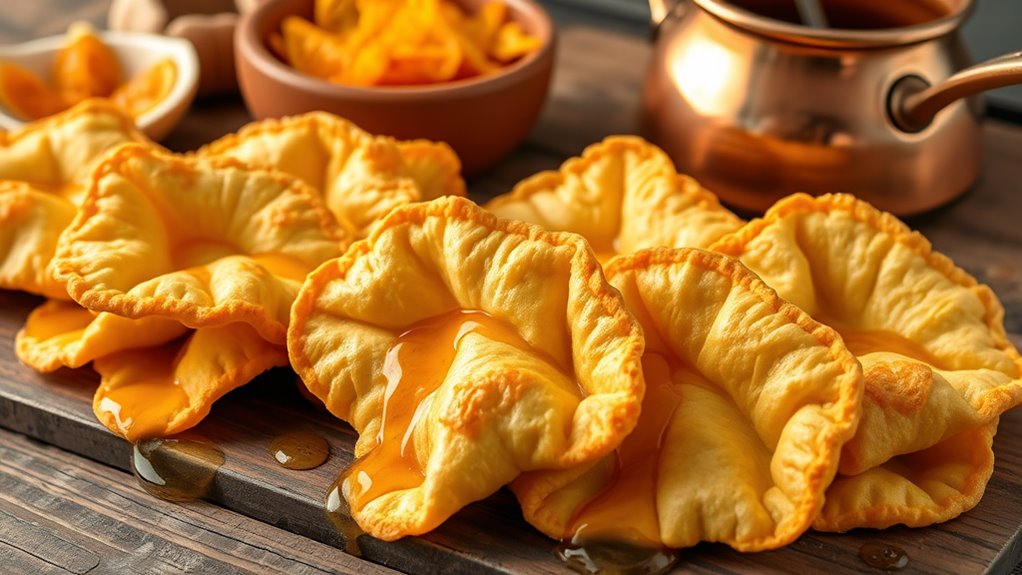
To achieve the perfect texture and flavor in Sardinian desserts, mastery of specific preparation techniques is essential. Start with the traditional pasta violada, made from durum wheat semolina flour and pork lard, then let it rest in the refrigerator for at least 30 minutes to relax the gluten and improve elasticity. Use lukewarm water to incorporate the fat evenly without melting it. When preparing fillings, select aged Pecorino Sardo or fresh sheep’s milk ricotta, adding citrus zest and beaten eggs to bind without thickeners. Shape the dough by hand into thin rounds, sealing the edges tightly to prevent leaks. Fry sebadas in hot oil until crispy, or bake pardulas until golden. Proper temperature control and gentle handling guarantee authentic, crisp, and flavorful desserts. Ensuring proper resting time improves dough elasticity, which is crucial for achieving thin, evenly rolled pastry shells. Additionally, knowledge of traditional ingredients ensures authentic flavor profiles and preserves cultural heritage.
Pairing Sardinian Sweets With Local Wines and Liqueurs
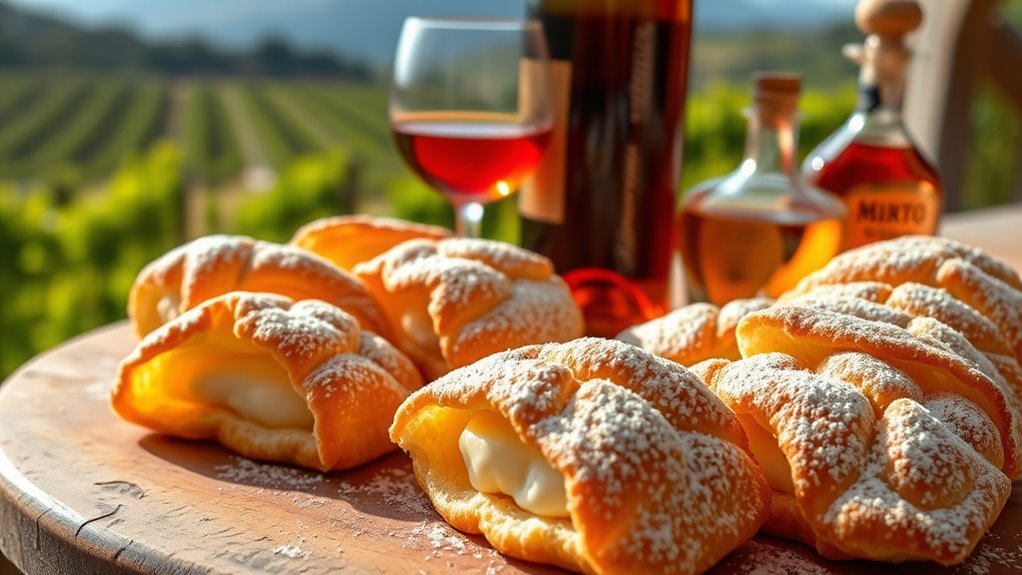
Pairing Sardinian sweets with local wines and liqueurs enhances their flavors and creates a harmonious tasting experience. The right pairing balances sweetness, acidity, and tannins, elevating each bite. Sardinian wines such as Vermentino di Sardegna, Cannonau, and local liqueurs are traditionally used to complement these desserts. 1. Vermentino di Sardegna pairs well with lighter desserts like pardulas, thanks to its invigorating acidity that complements ricotta and saffron. 2. Cannonau, with its fruity and spicy notes, is perfect with stronger sweets like sebadas, balancing the cheese and honey. 3. Sardinian liqueur wines, often made from native grapes, enhance nutty or chocolate semifreddi and traditional cookies like piricchittus, adding depth and richness. Additionally, understanding the local wine culture can deepen the appreciation of these pairings and the island’s culinary traditions.
Modern Twists and Contemporary Favorites in Sardinian Confectionery
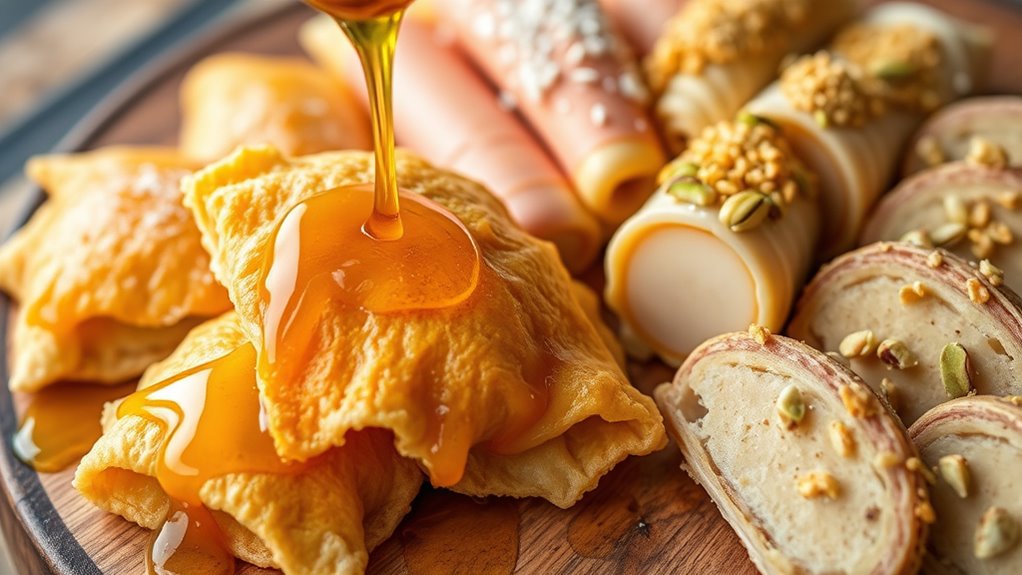
Modern Sardinian confectionery seamlessly blends tradition with innovation, as artisans reimagine classic sweets to suit contemporary tastes. You’ll find sebadas now filled with ricotta, chocolate, or fruit compotes, giving a fresh twist to the beloved fried pastry. Local ingredients like seasonal honey and citrus infusions boost flavor, while gluten-free and lactose-free options cater to evolving dietary needs. Presentation styles have shifted toward mini desserts and plated gourmet treats, perfect for modern dining. Traditional biscuits like Savoiardone di Sardegna serve as bases for tiramisù or layered parfaits, blending heritage with creativity. Recipes are evolving, maintaining authentic flavors while exploring new textures and ingredients. This ongoing innovation keeps Sardinian sweets relevant and appealing, both locally and internationally.
Frequently Asked Questions
What Are the Main Differences Between Seadas and Casadinas?
You want to know how seadas and casadinas differ. Seadas have a thin, flaky dough that’s fried until crispy, with a tangy Pecorino cheese filling that melts during frying. Casadinas, however, feature a thicker, baked pastry with a milder, often sweetened ricotta filling. The frying gives seadas a crunchy texture, while baking makes casadinas softer. These differences reflect their unique textures, fillings, and cooking methods.
How Are Traditional Sardinian Sweets Preserved and Stored?
You preserve and store Sardinian sweets using traditional methods that rely on natural techniques. After baking or frying, you let them cool in well-ventilated, dry spaces to prevent moisture and maintain crispness. You often store them in cool, dry areas, sometimes wrapping them with natural materials like wax paper or cloth to protect from humidity. For longer shelf life, you might use airtight packaging, but refrigeration isn’t common unless necessary for dairy-filled sweets.
Can Sardinian Sweets Be Made Gluten-Free or Vegan?
You can make Sardinian sweets gluten-free or vegan by substituting key ingredients. Use gluten-free flours like rice or almond flour for dough, and plant-based options like vegan ricotta and egg replacers to replace dairy and eggs. Keep in mind, maintaining the traditional texture and flavor may be tricky, but with careful adjustments, you can enjoy authentic tastes while respecting dietary restrictions. Just guarantee cross-contamination is avoided and experiment for the best results.
What Are Common Local Variations of Amaretti Across Sardinian Regions?
You want to know about local variations of amaretti across Sardinian regions. In different areas, you might find recipes with added orange zest or flavored with coffee or cocoa, reflecting local tastes. Some versions feature a whole almond on top, while others emphasize a softer or crunchier texture. These regional tweaks highlight Sardinia’s rich culinary diversity, making each amaretti unique yet rooted in tradition.
Are There Specific Customs or Rituals Associated With Giving Sardinian Sweets?
You’ll find that giving Sardinian sweets is more than just a gesture—it’s part of deep-rooted customs and rituals. During celebrations like baptisms, weddings, and Holy Communions, sweets such as Is candeberis are given to symbolize blessings and good fortune. You may also participate in communal preparations that strengthen social bonds. These acts honor tradition, mark important life moments, and preserve the cultural significance of sweets in Sardinian life.
Conclusion
As you savor Sardinian sweets like seadas and amaretti, you immerse yourself in a tapestry of tradition woven with flavors and stories. These confections are more than just treats—they’re the heartbeat of Sardinia’s rich cultural landscape. By exploring their unique ingredients and techniques, you connect with a heritage as enduring as the island’s rugged coastline, discovering that these desserts are the sweet poetry that binds past and present in a delicious embrace.
